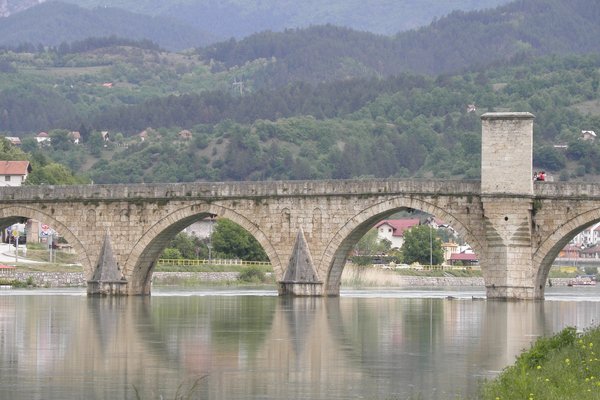Bosnia Herzegovina
Mehmed Paša Sokolović Bridge
The Mehmed Paša Sokolovic Bridge in Višegrad is one of the best remaining examples of Ottoman architecture and civil engineering.
The bridge was built at the end of the 16th century by the Ottoman court architect Sinan at a strategic border location. Spanning the Drina River, it is almost 180m long and has 11 arches. The Ottoman Grand Vizier Mehmed Paša Sokolovic, who was born in this area, ordered the construction.
Community Perspective: then and now a bit of an outpost, located in Republika Srpska. Views from above (as photographed by Clyde) are especially striking.
Site Info
Official Information
- Full Name
- Mehmed Paša Sokolović Bridge in Višegrad (ID: 1260)
- Country
- Bosnia Herzegovina
- Status
-
Inscribed 2007
Site history
History of Mehmed Paša Sokolović Bridge
- 2007: Inscribed
- Inscribed
- Type
- Cultural
- Criteria
- ii
- iv
Links
- UNESCO
- whc.unesco.org
- Official
-
- visegradturizam.com — Visegrad tourism
- Related
-
- en.wikipedia.org — Biography of Mehmed Pasa Sokolovic
- archnet.org — Description of the bridge at ArchNet
All Links
UNESCO.org
- whc.unesco.org — whc.unesco.org/
Official Website
- visegradturizam.com — Visegrad tourism
Related Resources
- en.wikipedia.org — Biography of Mehmed Pasa Sokolovic
- archnet.org — Description of the bridge at ArchNet
News Article
- Dec. 22, 2015 dailysabah.com — Bridge on the Drina gets a Turkish facelift
Community Information
- Community Category
- Secular structure: Civic and Public Works
Travel Information
Recent Connections
View all (15) .Connections of Mehmed Paša Sokolović Bridge
- Geography
- History
-
-
Ottoman Empire
Example of Ottoman architecture and engineering -
Places of Execution
The bridge was the site of numerous executions during the Visegrad Massacre in 1992
-
- Architecture
- Damaged
-
-
Damaged in World War I
"During World War I, in 1914-1915, piers 3 and 4 were blown up with dynamite" (AB) -
Damaged in World War II
Five of its 11 arches were damaged during World War II
-
- World Heritage Process
- Constructions
- WHS on Other Lists
-
-
Located in a TCC Territory
Srpska -
World Monuments Watch (past)
(2006)
-
- Timeline
-
-
Built in the 16th century
The Visegrad Bridge was constructed from 1571 to 1577 (AB ev)
-
- Visiting conditions
- WHS Names
-
-
Named after individual people
Ottoman statesman and Grand Vizier Mehmed Pa?a Sokolovic
-
- Literature & Film
-
-
Works by Nobel Prize winning authors
The Bridge on the Drina by Ivo Andri
-
News
- dailysabah.com 12/22/2015
- Bridge on the Drina gets a Turkish…
Recent Visitors
Visitors of Mehmed Paša Sokolović Bridge
- Alexander Barabanov
- Alexander Lehmann
- Alex Marcean
- Aljaz
- Ana Lozano
- Andrew0181
- Anna Wludarska
- Argo
- Atila Ege
- beckyjo27
- Bin
- Christian Wagner
- Christravelblog
- Clyde
- ctravel
- Dagmara
- Dan Pettigrew
- David Berlanda
- DavidS
- Dimitar Krastev
- dmscanlan
- Dorejd
- Elaine McArdle
- Els Slots
- Evgenii
- Fan Yibo
- Filip Murlak
- futtaimhb
- Gabor
- Gary Arndt
- GeorgeIng61
- Gernot
- Harald T.
- Harry Mitsidis
- heywhatever2
- Iain Jackson
- Ivan Rucek
- Jakubmarin
- janis
- Jarek Pokrzywnicki
- Jasam
- Jeffrey Chai
- Jezza
- John Smaranda
- Jonas Kremer
- Juha Sjoeblom
- Justin
- jxrocky
- KarenBMoore
- KateY
- Kevin McFarland
- Knut
- krtek
- Lara Adler
- lichia
- Lisu Marian
- Luis Filipe Gaspar
- Maciej Gil
- marcel staron
- Martina Rúčková
- Mikko
- Milan Jirasek
- Miloš Tašković
- MoPython
- nan
- Nihal Ege
- nikolamus
- PabloNorte
- Patrik
- petar
- Peter Lööv
- Philipp Leu
- Philipp Peterer
- Pincze
- Piotr Wasil
- Rafał Kałczuga
- Randi Thomsen
- Remski
- Rick Ohm
- Roger Ourset
- Roman Bruehwiler
- Roman Raab
- Sebasfhb
- Sergio Arjona
- sime147
- Slavi
- Solivagant
- Ssong.x
- Stanislaw Warwas
- Svein Elias
- Szucs Tamas
- Tamara Ratz
- Taotao Chen
- Tarquinio_Superbo
- Tevity
- Thomas Buechler
- Thomas van der Walt
- Tinamu
- tony0001
- triath
- Tschibi
- Tsunami
- Twobaconsandaboston
- WalGra
- Walter
- Wojciech Fedoruk
- Xiong Wei
- YaroMir
- Yevhen Ivanovych
- Zach
- Zoë Sheng
Community Reviews
Show full reviews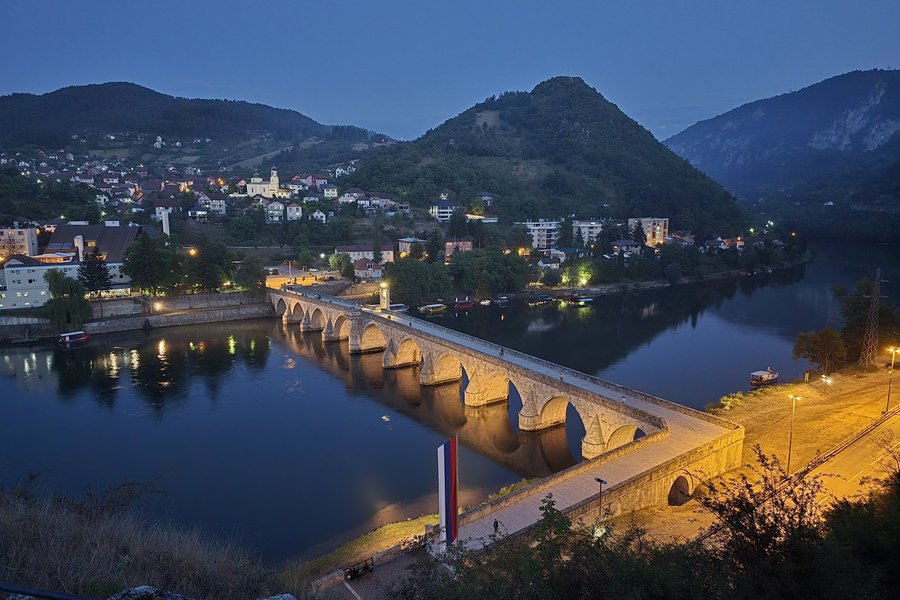
We were staying in Uzice in Serbia and caught a bus to visit this site located in Visegrad, Bosnia & Herzegovina. It was a 2hour bus trip that left at 11.00am, all be it there was a 20 minute rest stop along the way and 2 border checkpoints which make up most of the time. I won’t go into the history of the site as this is well covered by other reviews, however the site is certainly a highlight of Visegrad and a feature of this town. I explored the bridge from the riverbank, itself, crossing the bridge as well as from the hill nearby and getting the drone up as well. The only thing I did not do was get a boat tour under the bridge, of which there are a number of operators. My return bus did not leave until 1.00am the following morning, so got to experience the bridge under the changing light at different times. Whilst I can appreciate the history of the bridge, if you did not know it yourself, it would probably be underwhelming to a visitor to the town.As stated on previous reviews, make sure you take the opportunity to climb the small hill opposite the bridge to the top of the Zipline site, the view is very much worth it.
Keep reading 0 comments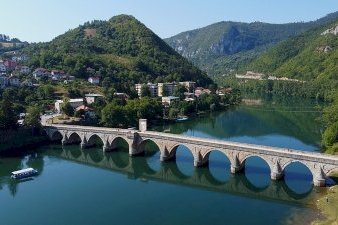
I visited this WHS in 2022 en route from Stari Ras, Serbia to the Bosnian Stecci near Stolac. Arriving very early from the opposite side of Visegrad, I easily parked alongside the Drina River where a local fisherman was trying his luck and killing time. The 11 arched Ottoman bridge is quite striking, especially when seen from above, either with a drone or with a short walk up a few stairs to the local zipline.
It has become quite popular in the last few decades thanks to Ivo Andric who wrote the novel The Bridge on the Drina in 1945. A whole tourist quarter named Andricgrad is located just a pleasant stroll away from the bridge with great views from near the Church of the Nativity of the Blessed Virgin. Another great viewing point is from the terrace restaurant/cafeteria of the cheap Hotel Visegrad where I had some breakfast. Next to the hotel, several small boat tour companies organise 30 minute boat trips on the Drina river focusing mainly on the bridge. There is a black UNESCO WHS inscription plaque just opposite the stairs which lead to the zipline.
Apart from the sheer size of the bridge, the architectural feature which stands out is definitely the central pile with Arabic script. The bridge was originally constructed between 1571 and 1577. However, major renovations took place in 1664, 1875, 1911, 1940 and 1950–52. Three of its 11 arches were destroyed during World War I and five arches were damaged …
Keep reading 0 comments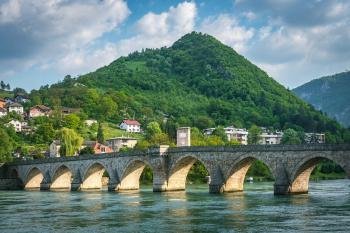
I visited the site in April 2016.
It is not difficult to get to. If you have a car it is about a 2-hour drive from Sarajevo. Once you arrive in Višegrad, it is pretty hard to miss, as the river is the dominant feature going through the town.
The bridge is currently only open to foot or bicycle traffic and it is visible from the modern bridge which is used by cars. There is a small parking area available off the road which is connected to the bridge by a walking path.
Read more about the Mehmed Paša Sokolovic Bridge in Višegrad on my website.
Keep reading 0 comments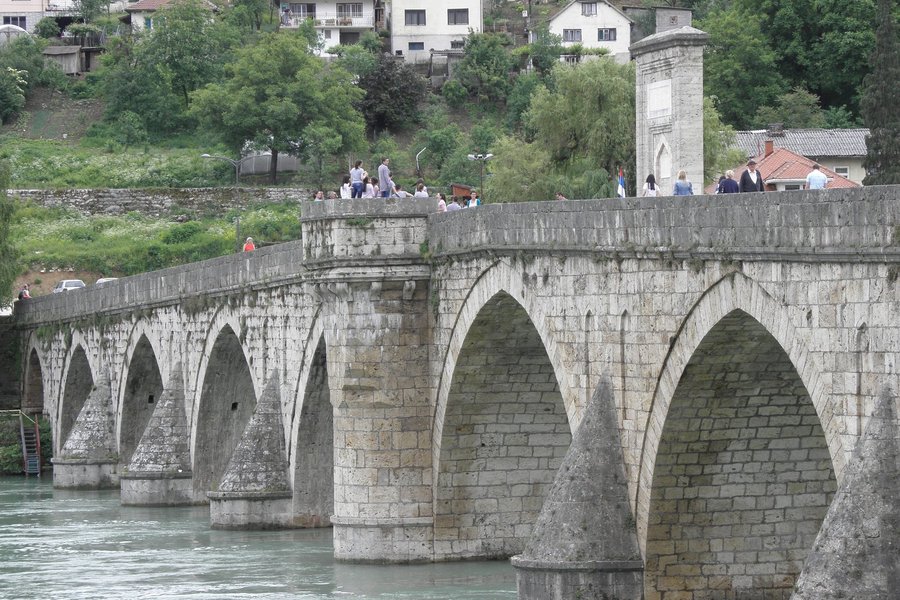
Visited March 2016
There's only one bus a day from Lukavica bus station, East Sarajevo, to Visegrad, at 3pm. All other buses (at least 5, the first one at 07:30 am) were moved to the new bus station in Pale, 16 km east of city center; the only way to get there from Bascarsija is by taxi, as there are no any public connections between Sarajevo and Serbian East Sarajevo. In Visegrad all buses stop by the bridge. There's no bus station in the city so if you're heading out of the city, just wait at the NW edge of the bridge.
Half an hour is good enough to admire this WHS from all the angles, climbing the nearest rock included.
No much to see in Visegrad apart the Sokolovic Bridge: Ivo Andric's house (closed to the public) and Andricgrad, a new tourist place with nothing interesting in.
Keep reading 0 comments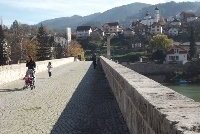
The bus journey from Sarajevo to Visegrad is slow but scenic. About half of the 3 hours was spent on smoko stops. But reaching the Lukavica bus station requires an hour's journey by a #103 trolleybus from downtown Sarajevo to Dobinja, then walking across the invisible border to the Republica Srpska bus station. But by starting out early I managed the return journey in a day.
Keep reading 0 comments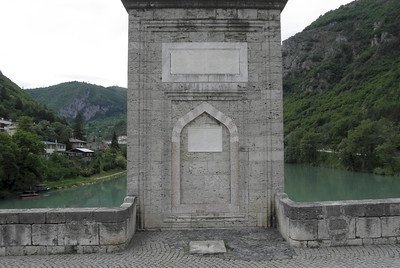
This seldom visited WHS lies hidden in the far east corner of Bosnia Herzegovina. I visited it on a day trip from Sarajevo: 3 hours to get there, 75 minutes in Visegrad, and then 3 hours on the bus back. It's a sacrifice one sometimes has to make in pursuit of visiting as many WHS as possible. The fun thing was: I wasn't the only one who had chosen to spend the day like this. An elder Japanese couple did exactly the same outing, just for taking some pictures of the bridge and then turn back to Sarajevo.
The bridge is closed to traffic nowadays, but pedestrians can cross. A large group of local youth was singing and drinking beer near the mihrab at the center of the bridge - a celebration of the end of the school year I believe. Otherwise, it is just used as a shortcut between Visegrad city and the houses on the other side of the river. There's a new bridge 1km upstream where motorized traffic is directed to.
I wasn't really perplexed by the bridge at first sight. It's a rather sober construction, obviously a grand piece of work in its time but a bit underwhelming in 2013. Due to human impact, the water level has risen over the years so the bridge looks different now than when Sinan designed it. The pillars almost aren't visible anymore.
Getting to Visegrad means that you enter the Republika Srpska, the autonomous part of …
Keep reading 0 comments
There are only three bridges on the UNESCO list so far, so I think this is a special monument to se. Behind it's architectual value it had a big influence on the culture of people in Bosnia and Herzegovina. The bridge is also famous thanks to the only Nobel prize winner from Ex Yugoslavia, Ivo Andric, who wrote a book about the bridge.
At this moment I am preparing materials for the official web site of Tourist organization of Visegrad (www.visegradtourism.com), where the bridge is situated, and the text below is a part of that materials.
I hope you will find it usefull, but if you want to find out more about Visegrad visit visegrad web site.
The Bridge on Drina River
The Višegrad Bridge is a heritage of the great vizier Mehmed-pasha Sokoloviæa (in Turkish Sokollu Mehmet Paºa, 1505. or 1506-1579).
He is one of the great Osmanli war generals by origin from Bosnia. He was born in the village of Sokoloviæi near Rudo in 1505. or 1506, and was a child of Orthodox parents. At that time there was a tradition known as Divširma, or „The contribution in blood”. Serbian children would be taken away by force to Turkey where they would be converted in Islam and taught in their military schools to become Janjièari, the elite soldiers of the Turkish Empire. So was Bajica Sokolovic taken as a child from the surroundings of Višegrad and given the name Mehmed. Later on he would become the great vizier …
Keep reading 0 comments
Mehmed Paša Sokolovic was a local lad made good who rose to become one of the most senior figures of his day in the Ottoman Empire. As this part of what is now Bosnia was something of an outpost, this is quite impressive - a bit like an Indian becoming prime minister in Victorian Britain. He sponsored the building of this bridge by one of the great architects of the time, and this Višegrad bridge is considered one of the finest examples of Ottoman bridge design, hence its inscription. I struggled to get more info than this about the bridge as the newly built tourist office was not geared up for non-slavic speakers.
Set on the outskirts of what is now a sleepy little town - at one end is a nice cafe for relaxing in the shade of the trees by the river - it is a very pleasing-looking bridge, in pretty good repair (having been extensively reconstructed following floods etc.) but hard to recommend as a must-see unless you have a passion for Ottoman bridges. The valley it sits in is picturesque, and it makes for a good break if you're driving between Sarajevo and Belgrade.
Keep reading 0 comments
